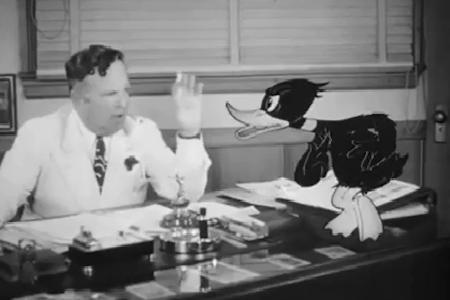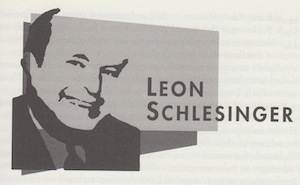At the height of competition for animated shorts, Leon let the young cartoonists loose.
By Scott Smith
Born: September 9, 1884, Philadelphia, PA
Died: December 25, 1949, Los Angeles, CA
Schlesinger was no artist, he was a moneyman.
—Leonard Maltin
In 1929, when financial woes threatened the Warner Bros. studio, executive Sam Warner put a tremendous amount of faith in two men—Hal Wallis and Leon Schlesinger. Wallis, one of the industry’s most respected figures, would eventually oversee more than four hundred of the most popular features in the history of Hollywood (most notably gangster films) that collectively scooped up thirty-two Academy Awards and 121 Oscar nominations from the late 1920s to the mid-1970s. Schlesinger, on the other hand, was in charge of Porky Pig.
Leon Schlesinger had been a financial backer of Warner Bros.’ gamble on sound films, bankrolling The Jazz Singer (1927) and profiting handsomely from its success. A producer of several early John Wayne westerns, Schlesinger also owned a title effects company in Hollywood called Pacific Arts and Titles, which had a long-standing contract to provide dialogue cards for most of Warners’ silent feature films. This production experience, combined with the excellent facilities Schlesinger possessed, gave Warner an idea.
Sam Warner had a problem he thought Schlesinger could solve. Owning more than seventeen thousand theaters in roughly seventy-five hundred towns throughout the nation, Warner Bros. had more than 10.5 million seats to fill with paying customers. To attract patrons on a regular basis, he needed a steady stream of new features, serials and animated shorts. He proposed a deal with Schlesinger that would give Warners a fresh cartoon every two weeks. Schlesinger could handle production any way he liked; Warner would take care of distribution.
To complete twenty-six cartoons a year, Schlesinger would require several established animators, preferably those with proven characters. He had heard that artists Rudy Ising and Hugh Harman had developed a few shorts featuring the antics of a character named Bosko, so he hired them, along with animator Friz Freleng, at $200 a week each and began a series of cartoons in 1930 based loosely on Disney’s Silly Symphonies, called Looney Tunes.
The success of their first short starring Bosko, Sinking in the Bathtub (1930), launched a second series, called Merrie Melodies, and put pressure on Schlesinger to make one cartoon a month for the next three years. A typical seven-minute cartoon required 5,040 drawings and cost nearly $30,000. Since cartoon shorts often take up to twelve months from conception to delivery, Schlesinger devised a system whereby each animator would have to be the lead “director” on several projects simultaneously to complete two shorts a month.
Immediately, Harman and Ising wanted out of the hectic pace, and they took Bosko with them. A desperate Schlesinger corralled the talents of Robert McKimson, Bob Clampett, Chuck Jones and Tex Avery and refocused these men away from melody-based cartoons to character-driven plots. He was forced to compete with new cartoon personalities being introduced by MGM and others. Schlesinger conceived of the idea of developing an “Our Gang” of cartoon characters modeled on the comedies of the Hal Roach studio. He handed the task to his young animators, and soon Bob Clampett had an idea. Clampett showed the group drawings of a curly-tailed pig and black cat, named Pork and Beans. It was the first sketch of Porky Pig, and Leon knew the perfect voiceman for bringing him to life—stuttering contract actor Joe Dougherty. Warners had a new star, and Schlesinger was back on schedule.
He then focused on cartoons that would win Academy Award recognition, and Friz Freleng became the first Warners director to win an Oscar nomination, with It’s Got Me Again (1931). Tex Avery, however, would create cartoons that showered the Warners division with more Oscars and more respect. MGM began to notice the up-and-coming young Warners team, and Schlesinger used the attention to recruit more talent. He lured Ub Iwerks, Frank Tashlin and movie theater organist Carl Stalling (who had been behind Disney’s Silly Symphonies) into his own cartoon stable. Another prize acquisition was radio personality Mel Blanc, who provided more than four hundred distinct voices for three thousand shorts—a whopping 90 percent of all WB cartoons. In 1937, Blanc took over the dialogue of Porky Pig and Daffy Duck; in 1940, he introduced “Happy Rabbit,” the Brooklyn Bunny later known as Bugs.
At the height of competition for animated shorts, Leon let the young cartoonists loose. His hand-off approach resulted in the wackiest collection of classics ever assembled, including such celebrated films as The Daffy Doc (1938), A Wild Hare (1940) and Inki and the Minah Bird (1943), as well as a legacy of interchangeable antagonists like Sylverster, Foghorn Leghorn, Speedy Gonzales, Pepe LePew and Yosemite Sam.
Much has been made of the free rein the animators had at Warners. It has been suggested that Leon was an absent manager who cared little for the product, a criticism that lacks foundation. He oversaw story ideas, motivated the animators with contests and bonuses, brainstormed new characters, hired and fired, handled the day-to-day management of the talent by promoting and developing his employees and devised long-term plans for Clampett, Jones and Freleng specifically. To keep harmony among his temperamental artists, he often lent out animators, giving them a chance to work for Walt Disney, MGM or the Walter Lantz studios. If animators left his studio for other commissions, Schlesinger never hesitated hiring those same employees back years later when they became available. But the animators did have contempt for their boss. The voice of Daffy Duck was a pointed jab at Leon’s lisp. They presented the voice to him and snickered when he didn’t see the obvious parody.
Schlesinger struggled to keep his animators happy. Tex Avery, who had dreamed up a series of talking animal shorts, asked Schlesinger to retool the studio for live-action shorts or stop-motion experiments. The dispute turned sour, and Avery was punished with a lengthy suspension, returning only to resign from Warners. After the incident, Clampett asked to develop a hand-puppet series and was allowed his Cecil and Beany shorts, which eventually became a television show. Others, like Freleng, were lured to MGM by the sheer prospect of more money, but came back to Warners on Leon’s initiative.
In 1944, Schlesinger sold his interest in the animation venture to Warners, but he stayed on until 1946 to run the operation. He handled the merchandising of characters created during his reign, and he negotiated television rights and promotional tie-ins on behalf of the Warner Bros. studio. By then, the key players were permanently rooted; Freleng continued as head animator on more than three hundred projects, Chuck Jones would hone his timing and become a legendary master through an association with Warners that spanned sixty years and Robert McKimson remained for thirty-two years until the studio shut its doors.
Schlesinger left just in time; the conditions of the industry had changed since Sam Warner first approached him. A historic 1948 Supreme Court ruling, stating that Hollywood was monopolizing the entertainment field, ordered all production companies to sell any movie theaters they owned. Studios were forced to become independent distributors and convince theater owners to run their cartoons. But theater owners didn’t want to pay for seven-minute cartoons that cost roughly the same as ninety-minute features. With annual costs of lose to $1 million, the frugal boss of the Warners studio, Jack Warner, felt “there is no money in short subjects.”
Furthermore, when Schlesinger left, the relationship between the studio and the renegade department became strained. Schlesinger had permitted only a minimum of interference from Warners when he was in charge: Jack Warner claimed never to have set foot inside the animation building. Once Schlesinger departed, Warner appointed Eddie Selzer to run things. His mission was clear: find a more economical way to make cartoons. Selzer instituted cost-cutting measures and demanded that every animated short be scripted, something the animators only did loosely in storyboards. Clearly, Selzer wasn’t the man to change the ways of the free-wheeling Loonies. Warner grew impatient and closed the studio briefly in 1955, giving animators a hiatus. Upon their return, things hadn’t changed, and Jack Warner was resolute.
The demise of the famous studio came in 1963, relegated Looney Tunes to television reruns. Today, these cartoons still enjoy the popular vote among millions of aficionados, many of whom are unaware of Schlesinger’s role.
To read all the republished articles from ‘The Film 100,’ go to Reintroducing the Film 100 here on Keyframe.





